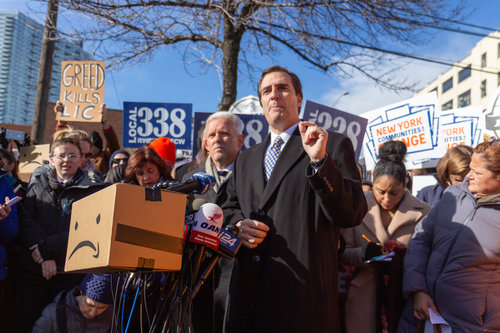
Amazon is officially coming to Queens. Great. Now what?
If you haven’t heard the news, the company announced that it will be splitting its second headquarters, known as HQ2, between Long Island City in Queens, New York and Arlington, Virginia. The move will allegedly bring at least 25,000 new jobs to both cities. In exchange, New York promised Amazon upward of $1.5 billion in tax incentives as well as used SUNY and CUNY students as leverage in the deal, for we provide “an unrivaled talent pool for Amazon.” Proponents of the New York deal boast that Amazon will help revitalize the industrial Long Island City. But at what cost?
It goes without saying that revitalization is code for gentrification. The most recent Long Island City census shows that 25.9 percent of the population is African American and 40.5 percent is Hispanic or Latino. More significant, though, is the prospective location of HQ2. Amazon will build its headquarters in close proximity to Queensbridge Houses, the largest public housing development in North America. Just think about that: Amazon, owned by Jeff Bezos, the richest man in the world, is planting its new headquarters literal city blocks away from an immense complex that houses thousands of low-income, predominantly black and Hispanic or Latino people. This is not even addressing the more than 60,000 homeless families in New York City. Amazon’s arrival in Queens will undoubtedly exacerbate the already existing disparity in the city.
This is bad enough, but we must also consider that Long Island City has already been undergoing gentrification in recent years, particularly due to a 2001 rezoning of the area that made way for increased office space, stores and residential high-rise buildings. If you grew up in or around Queens like me, you’ve likely seen the bustling construction on your 7 train commute between Queens and Manhattan. As such, these luxury developments have already attracted more well-off individuals while rents in Long Island City continue to steadily rise. Moreover, as soon as Amazon announced its HQ2 plans, searches for homes in Long Island City reportedly spiked dramatically on the real estate site StreetEasy. This is concerning. Already, if you walk through the area, the inequality is extremely blatant: Shiny, new high-rise buildings are juxtaposed against Queensbridge Houses and The Floating Hospital, a nonprofit hospital that provides medical care to homeless and low-income people. How much worse will the problem get?
To get a glimpse at how this project will play out, we can look to Amazon’s imprint on Seattle, Washington, where its main headquarters is located. Though we cannot assume that the circumstances and effects will be identical, some aspects can inform our predictions of Amazon’s impact on Long Island City. In particular, though Seattle has the third largest homeless population in the country, the city’s median rent increased three times as much as the U.S. average over the past 10 years. Likewise, as buildings were constructed to support Seattle’s burgeoning population, the majority of them have rents that are 40 percent more expensive than those of older buildings. These housing trends are cause for concern when considering the conditions of Long Island City I’ve previously mentioned.
We should also draw attention to how a corporation like Amazon impacts a community outside of just housing prices. Business Insider writer Harrison Jacobs described walking through Seattle’s ‘Amazonia’ area: “There is a strange vibe that Amazon controls everything. Amazon security guards questioned [a] photojournalist about what she was doing — on public property. Shortly after, the guard began filming me, saying Amazon documents all media personnel. I hadn’t identified myself as a reporter.” This sort of hypersurveillance on public property should be a red flag, especially bearing in mind that Long Island City is largely composed of racial minorities. This is on top of the fact that Amazon offered Immigration and Customs Enforcement its facial-recognition software to help the agency identify immigrants.
Amazon has more than its fair share of problems that I have not even delved into. For now, though, the focus must be on the incoming massive transformation of Long Island City and its surrounding areas. Black and brown people will undoubtedly bear the brunt of Amazon’s HQ2, building upon the already existing inequalities in the city. We don’t fully know what will happen to Queens, but we must stay cognizant, for the effects will surely be felt for decades to come.


